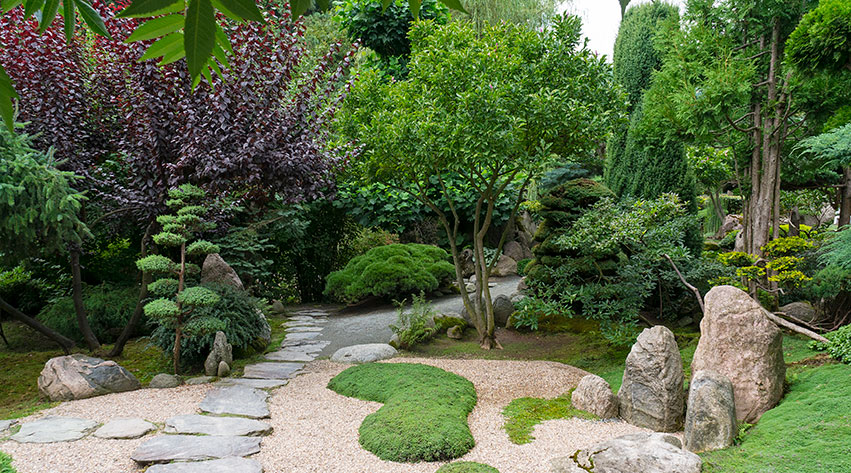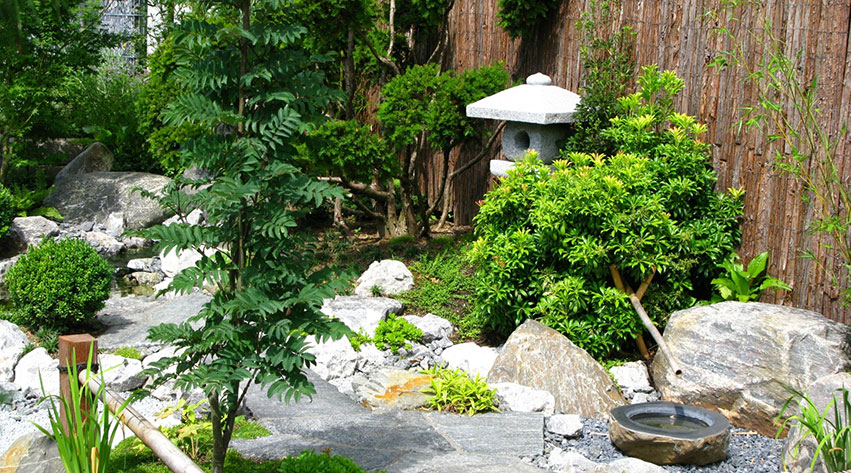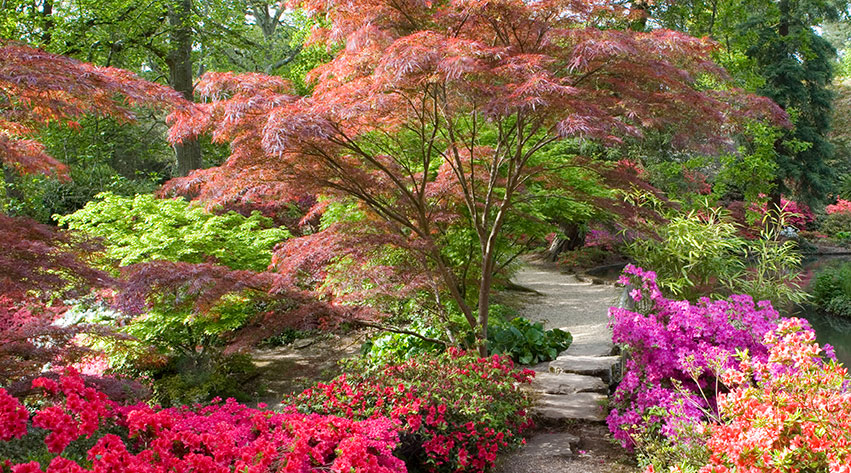- Planning is more important in an Oriental garden than with any other design. While we always recommend thinking carefully about how you’re going to implement a theme within your garden, careful contemplation before you start will help to create the sense of harmony that is synonymous with this style. Sketch out what you’d like the garden to look like and think about what elements you’d like to see.
- There are four main garden types when taking on an oriental theme, and each has a different purpose or works best in a particular area. A stroll garden tends to work well if you have a lot of space and is made up of winding paths and stepping stones. A dry garden tends to include sand or gravel as ground cover which is then raked to symbolise water. An oriental courtyard garden relies on a compact amount of space and allows you to create miniature versions of each stylistic element, while the main purpose of a tea garden is to enjoy what you’ve created with a lovely cuppa.
- Water is an essential for the authentic oriental garden. Said to symbolise renewal, calm and wonder, you should experiment with ponds and streams on varying levels throughout the garden.
- Try to choose plants which will give interest all year round. Colour isn’t as widely used in an Oriental garden as in other designs, so it’s important to be quite creative but blossoms, Wisteria, Irises, Hydrangeas and Camellia can all be used in moderation to provide splashes of colour in an otherwise foliage dominated landscape.
- Beds and borders should, like everything in this garden design, mimic natural landscapes, so it’s important to avoid boxy beds and straight lines. It also works really well to use plants at the garden edge, which when grown, will disguise the straight lines of the borders and make your space feel larger.
- The focus of this type of garden is more on foliage than flowers, and limiting the number of different plants you use will help create a more authentic look.
- Concentrate on making mini landscapes in your garden to show off the shapes, texture and colour. Everything should be positioned in a way that imitates the natural landscape – so once again staying aware of avoiding straight lines and harsh shapes where possible.
- All elements of this type of garden should be positioned in an asymmetrical way, and preferably on the diagonal where possible. Odd numbers of plants, decorations, finishing touches work well too. Allow paths to meander like streams and try to create a mixture of open and enclosed areas where possible.
- Bamboo is a key material used in gardens in Asia so should be utilised if you’re hoping to recreate the same vibe here in the UK. Bamboo can be used for fencing, fountains and as the base material for a range of structures throughout the garden. It’s even worth considering planting a few stands of bamboo to further incorporate the style in your space.
- Closely clipped trees and shrubs are another key feature, so prepare to get familiar with creating topiary art. Ornamental shapes combine the smooth lines of the style with the tidy and fuss-free feel you’d expect in a tranquil space.




Oriental garden
Oriental Gardens are a haven of tranquility and serenity. The heavy Chinese and Japanese influence creates a distinctive feeling which couldn’t be more different from the garden styles we’re used to in the UK and can help bring stillness and calm to even the most bustling of cities and lifestyles, as well as to the smallest of spaces.
Unlike most other garden designs, the focus with an Oriental garden tends to be more on the elements that make up the design, rather than the plants. That’s not to say that plants don’t play an important part, but elements of rock, water and gravel combine with a limited planting palette to create a focus on how everything works together within the space. Sounds complicated? It isn’t really…it’s just a different state of mind.
Our top design tips
The finishing touches
It’s with the finishing touches that an Oriental garden really comes into its own. There are so many ways to take this theme to the next level, just by buying a few key features and placing them carefully in a well-considered space.
Bridges are a must if you have the space, but can obviously look out of place in a smaller garden. Oriental Garden style bridges tend to be made of wood, bamboo, earth or stone. Bamboo screens can be used to separate areas of the garden or add privacy, while a pagoda or an arbour can offer the perfect place to enjoy a cup of tea and a few moments of contemplation. Decorative features in a garden with this style tend to have a spiritual meaning, while bells and chimes can add another element of calm and relaxation.
Last but not least, one of the most important finishing touches for this theme is to make sure you take the time enjoy the tranquility you’ve created. Oriental gardens offer a unique sense of calm that can be really beneficial in the chaos of modern life!







